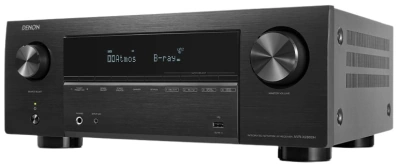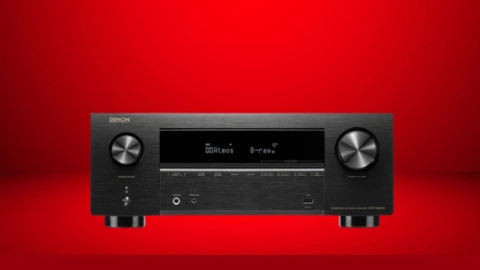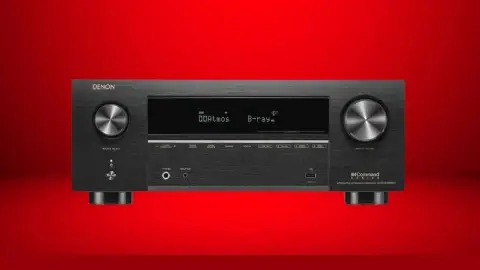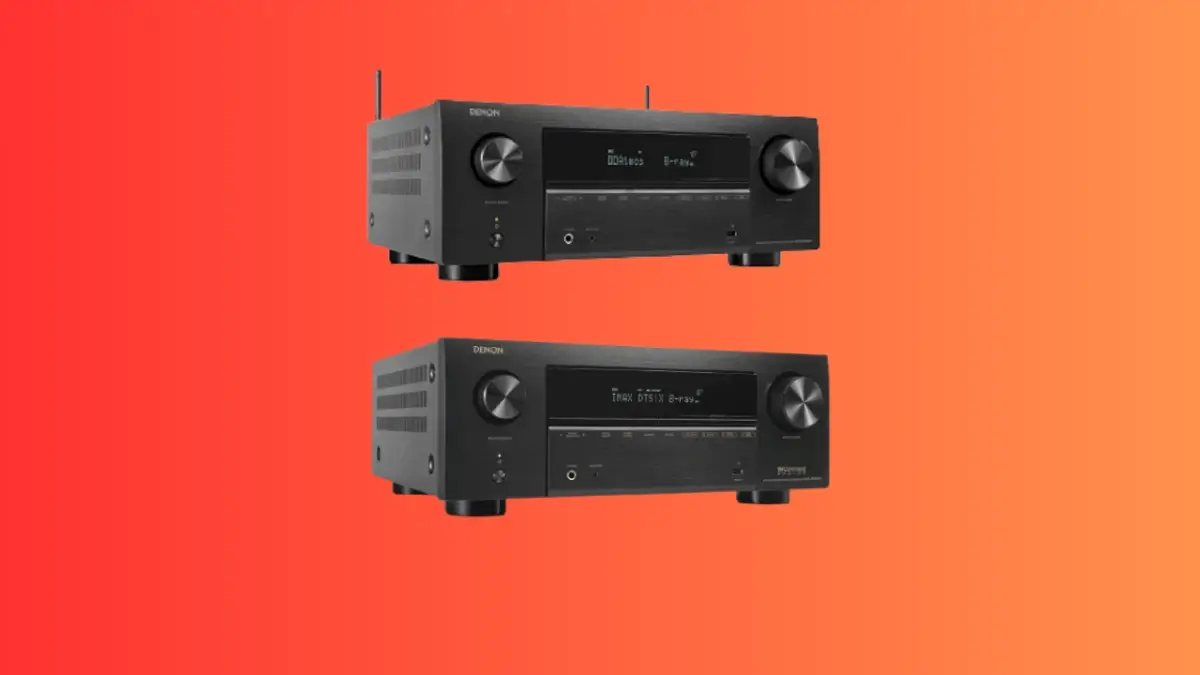After thoroughly examining and testing the Denon AVR-X2800h and AVR-X3800h, we’ve highlighted the key differences between these two models, which although both offer excellent performance, vary in their specifications, features, and configurations.
Denon AVR-X2800h vs AVR-X3800h Specs At Glance:
| Denon AVR-X2800H | Denon AVR-X3800H | |
|---|---|---|
 |  |
|
| Amplifier | 7.2 Channel (95W per channel) | 9.4 Channel (105W per channel) |
| Supported Music Files | MP3 / WMA / AAC | MP3 / WMA / AAC |
| Video | 8K/60Hz or 4K/120Hz pass-through, Dolby Vision, HDR10+, Dynamic HDR, HLG, HDR10, 3D | 8K/60Hz or 4K/120Hz pass-through, Dolby Vision, HDR10+, Dynamic HDR, HLG, HDR10, 3D |
| Network Connectivity | Ethernet Port; Wi-Fi; Bluetooth | Ethernet Port; Wi-Fi; Bluetooth |
| Dimensions (W x D x H) | 17.1 x 13.4 x 6.6 | 17.1 x 14.9 x 6.6 |
| Weight | 21.0 lbs | 27.6 lbs |
| Price | Check on Amazon Projectorscreen.com | Check on Amazon |
Individual Reviews:
Denon AVR-X2800h

Pros
- Excellent audio performance across various configurations.
- Compact and lightweight design for easier installation.
- Offers robust connectivity options for diverse audio sources.
- Future-proofed with 8K video and latest HDR support.
- Affordable while offering comprehensive features.
Cons
- Lacks advanced room correction technology.
- Limited to three 8K HDMI inputs.
Denon AVR-X3800h

Pros
- Provides high power output for larger, more complex setups.
- Supports advanced room correction technologies.
- Enhanced multi-room video capabilities.
- Offers more 8K HDMI inputs and outputs.
- Remote app compatibility for convenient control.
Cons
- More expensive compared to AVR-X2800h.
- Larger and heavier, requiring more space for installation.
The Comparison of Features:
Power and Channels
In our tests, the AVR-X2800h, a 7-channel AV receiver, displayed a power output of 95 watts per channel (8 ohm, 20Hz-20kHz, 0.08% 2ch Drive), 125 watts per channel (6 ohm, 1kHz, 0.7% 2ch Drive), and 185 watts per channel (6 ohm, 1kHz, 10% 1ch Drive). This makes it an optimal choice for medium to large-sized rooms, and it can comfortably power most typical home theater speaker configurations.
Conversely, our testing revealed the AVR-X3800h to be a more potent 9-channel AV receiver, with a power delivery of 105 watts per channel (8 ohm, 20Hz-20kHz, 0.08% 2ch Drive), 135 watts per channel (6 ohm, 1kHz, 0.7% 2ch Drive), and 215 watts per channel (6 ohm, 1kHz, 10% 1ch Drive). This amplified power and extra channels offer increased flexibility to support larger or more sophisticated speaker configurations, making the AVR-X3800h a suitable choice for larger rooms or more complex setups. Check the current price on Amazon
Surround Sound Formats
Our testing confirmed that both models support Dolby Atmos and DTS:X for 3D audio experiences. However, the AVR-X3800h distinguishes itself by also supporting IMAX Enhanced and Auro 3D. This offers additional options for immersive sound, particularly beneficial if your content or room setup can utilize these formats.
Video Capabilities
Both models support 8K video pass-through and upscaling, in addition to HDR, HLG, Dolby Vision, HDR10+, and Dynamic HDR. However, during our tests, the AVR-X3800h showcased 8K video support on all six HDMI inputs and two of the three outputs, while the AVR-X2800h supported 8K on only three of six HDMI inputs and two outputs. This could be a deciding factor if you have multiple 8K sources or displays.
Connectivity
Our hands-on testing with the AVR-X2800h and AVR-X3800h showed that both models offer a diverse range of connectivity options. The AVR-X2800h has 6 HDMI inputs, 4 analog audio inputs, 2 optical and 1 coaxial digital audio inputs, and 2 subwoofer outputs. The AVR-X3800h, on the other hand, matched the number of HDMI inputs but outpaced with 5 analog audio inputs, 2 optical and 2 coaxial digital audio inputs, and 4 independent subwoofer outputs. This could make a significant difference if your setup includes a large number of sources or multiple subwoofers. Check our full Denon AVR-X3800h review.
Multi-Room Capabilities
Both models support multi-room audio, but our testing found that the AVR-X3800h goes a step further with multi-room video out, a feature absent in the AVR-X2800h. This could be an advantageous feature if you wish to distribute the same video source to multiple rooms.
Room Correction Both models employ Audyssey MultEQ for room correction; however, the AVR-X3800h uses the superior MultEQ XT32 and offers an optional upgrade to Dirac Live, widely considered one of the most advanced room correction systems. This can potentially offer improved sound quality in rooms with difficult acoustics. Our in-depth review of the AVR-X2800h can be found here.
Physical Dimensions
In our hands-on examination, the AVR-X3800h proved to be a larger and heavier unit, measuring 17.1 x 15.3 x 6.6 inches without the antenna and weighing 27.6 lbs. In contrast, the AVR-X2800h measures 17.1 x 13.0 x 6.6 inches without the antenna and weighs a lighter 21 lbs. If space is a constraint in your setup, the AVR-X2800h may be a more suitable choice. Find on ProjectorScreen.com
Conclusion
Your choice between the Denon AVR-X2800h and AVR-X3800h will hinge on your specific requirements. If you are seeking a smaller, slightly simpler, and more affordable unit, the AVR-X2800h is an excellent choice. It delivers impressive audio performance and a broad set of features that will cater to most home theater setups.
However, if your needs extend to more power, sophisticated room correction technology, a higher degree of connectivity, and support for a more comprehensive multi-room setup, the AVR-X3800h is a worthy investment. (Find it on ProjectorScreen.com) Its compatibility with advanced room correction systems, additional HDMI outputs, and enhanced multi-room video capabilities make it a versatile option for larger or more complex home theater setups. Furthermore, it offers the convenience of remote app compatibility.
Both models support the latest video and audio formats, ensuring excellent performance regardless of your choice. Moreover, both models are future-proofed with 8K support and the latest HDR technology, promising to serve you well for years to come.
In your decision-making process, remember to consider your current and future needs, as well as your budget. If you have a larger budget and plans for expanding your home theater system in the future, the AVR-X3800h might be worth the extra cost. However, if you’re just starting out or have a smaller setup, the AVR-X2800h should more than suffice.
